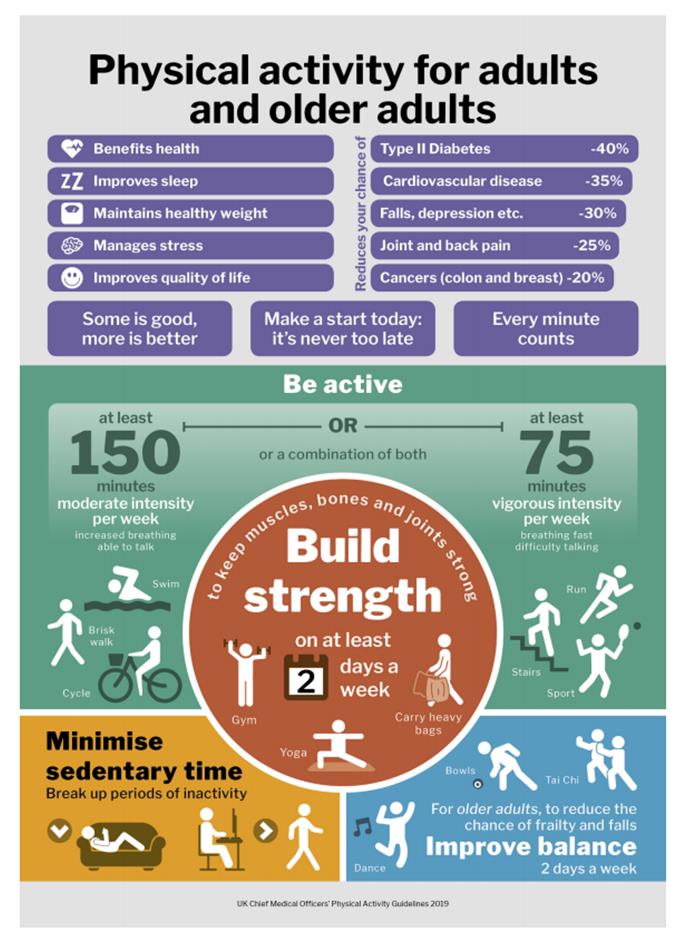Brain Tumour - Activity Advice for No Obvious Weakness after Surgery
What is the aim of this leaflet?
- To educate on the benefits and safety of exercise
- To empower to maintain a healthy level of exercise, long term.
- To encourage to stay at your normal level of day to day activity
Why exercise? Because you might develop:
- Poor sleep
- Fatigue – when you are more tired than normal throughout the day
- Reduced muscle strength, reduced heart and lung function
- Poor mental wellbeing, anxiety, depression, loss of confidence
Exercise can help manage these.
What do you need to consider when exercising with a brain tumour?
- For the first 6 weeks after surgery you should only do gentle activity. Don’t start any new exercise in this time. Gradually build up your activity and gain confidence. It is safe to be active after brain surgery.
- You might have an increased risk of having a seizure – if you are unsure discuss this with your doctor or specialist nurse. You may be advised to avoid swimming or cycling for an amount of time. This might also mean you can’t drive for a certain amount of time – the DVLA/specialist nurse will be able to advise you on this.
- If part of your skull is missing after surgery, you might be advised to wear a helmet or head protection for certain exercises or activities (for example, wear a cycle helmet if you resume cycling). Avoid contact sports such as boxing, rugby scrums, heading footballs. Your doctor, specialist nurse or therapy team will be able to tell you more.
Individualise Exercise and Activity for You
- Motivation – Aim for 150 minutes a week of moderate intensity exercise, or 75 minutes of vigorous exercise.
This can be 10 minutes at a time so it can be spread out during the week.
- Do activities you enjoy!
- Try and be active alongside your social/leisure activities – are there any sports you enjoy? Can you go for a walk with a friend? Can you play a game with the kids that get you moving too?
- Types – It is recommended to do some of each of the 4 types if you can
|
Aerobic – brisk walking stairs jogging walking up hills Zumba classes cycling football
|
Strengthening (aim twice a week) – bodyweight (press-ups, squats) hand weights resistance machines (in the gym) stairs carrying shopping or children gardening housework |
|
Stretches – stretching routine yoga pilates
|
Balance – Tai chi pilates yoga bowls dance |
Intensity – How hard do you want or aim to work?
- Moderate intensity – you should be able to talk but not sing whilst exercising
- Vigorous intensity – difficulty talking without pausing your exercise
If this is too difficult, remember that any moving around is good.
Useful Websites for information and ideas
- The Brain Tumour Charity – Information on the benefits of exercise and being active with a brain tumour.
https://www.thebraintumourcharity.org/
- Chartered Society of Physiotherapy (CSP) – Search for “Top tips for being more active”:
- DVLA website – for information on when it is safe for you to drive again
- Thinking of going for longer walks? Look into routes in your local areas – a lot of websites detail the intensity and any potential difficult spots for planned routes.
- Want to join a gym? Most gyms will offer a free gym session when joining to show you the equipment and may be able to guide your exercise plan.

- Last Updated:01 September 2023
- Review Date:30 September 2025
- Author:Emily Gerrans/Maja Woolwick
- Summary:
What is the aim of this leaflet?
- To educate on the benefits and safety of exercise
- To empower to maintain a healthy level of exercise, long term.
- To encourage to stay at your normal level of day to day activity